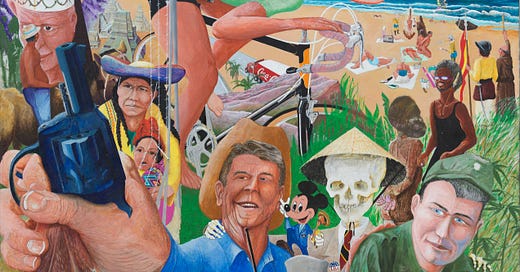Imitators and Frauds in the World of Fine Art
I was one, among many, young artists who had decided to migrate to Paris in search of success and meaningful experiences when Edouard Roditi adopted me and became my mentor.
I brought a rolled up, 4 X 5 foot canvas with me across the Atlantic, a work-in-progress. I spent my days as a street artist, working with pastels and charcoal to capture architecture, the bridges and street scenes that appealed to me. I worked on the spot, and sold the drawings to passersby, a typical activity in Paris at the time. I made enough money to cover my figure drawing classes at La Academie de la Grande Chaumiere, one of the oldest drawing studios in Paris. At night, I worked on the painting in my studio.
I met Edouard accidentally when I sat next to him at a poetry reading at Shakespeare and Company, a famous old bookstore in the city. I only later learned that he was one of the city’s most respected art critics. He agreed to look at The Reagan Years (above). He admired it and encouraged me to continue working. We became friends after dining together at his apartment and very soon he wanted to educate me about imitators and frauds in the world’s most famous city of art.
Edouard invited me to accompany him to dinner with a Russian painter and his wife at their home and studio in Montmartre. We were treated to a personal showing of his work, broke bread, and drank wine. The paintings were delicate representational studies of objects in still life.
The next day, Roditi took me to a gallery opening event, another Russian painter about to make a huge splash having gained representation and thereby the endorsement of a major French art house. Many other notable critics were there marveling at the work. As we walked through the exhibit, Roditi had a mischievous grin that cloaked a very sharp blade. He was laughing while weeping at the apparent fraud being committed before our eyes, The paintings hanging on the walls were almost exact duplicates of the works we had seen the previous night.
The two Russian painters were friends until quite recently when one of them discovered what had been taking place under the guise of being fellow, struggling artists in Paris. Roditi explained to me that even were the duplicity to be revealed, there would be no restoration of justice. Once the gallery had put forth a commitment of their credibility as critical authorities of art, they would be ruined as experts - so the gallery would never properly attribute the source of the original painting style to the proper artist. It was a lesson on how to swim safely among sharks.
It is said that Picasso stole his painting style from Africans after visiting a display of African masks at the Trocadero Museum of Ethnology.
“I forced myself to stay, to examine these masks, all these objects that people had created with a sacred, magical purpose, to serve as intermediaries between them and the unknown, hostile forces surrounding them, attempting in that way to overcome their fears by giving them colour and form. And then I understood what painting really meant. It's not an aesthetic process; it's a form of magic that interposes itself between us and the hostile universe, a means of seizing power by imposing a form on our terrors as well as on our desires. The day I understood that, I had found my path," Picasso confesses.
I personally believe that style is effortless, and comes without thought from a direct union with Source, the higher intelligence that surrounds us. It’s where Einstein claimed to find his inspiration, out here in the flow.





